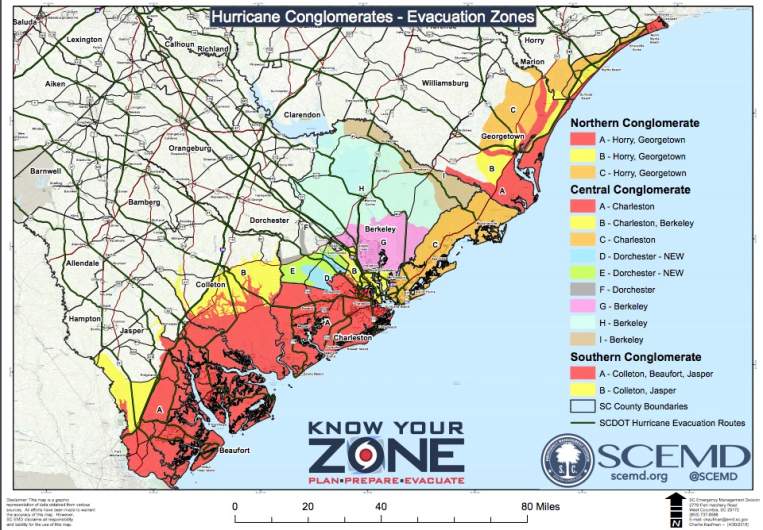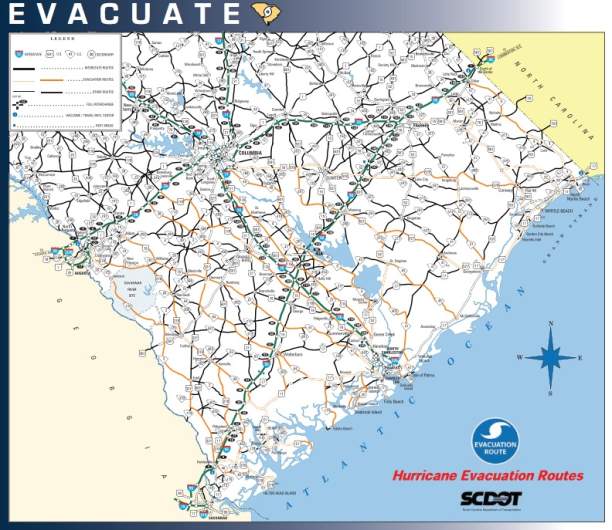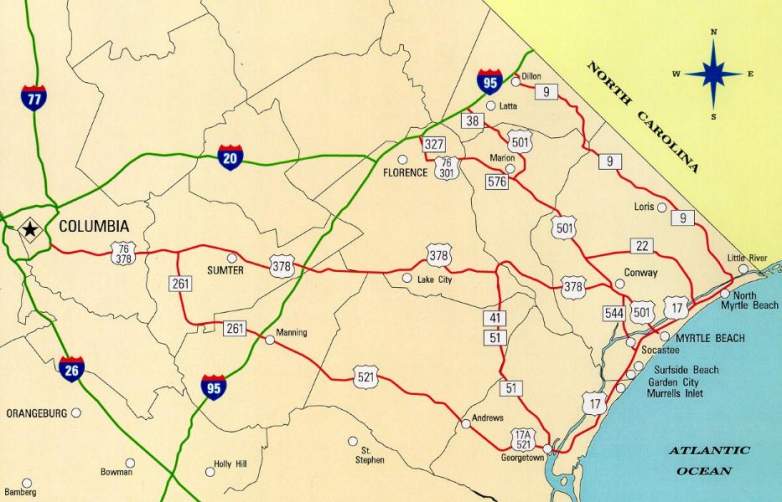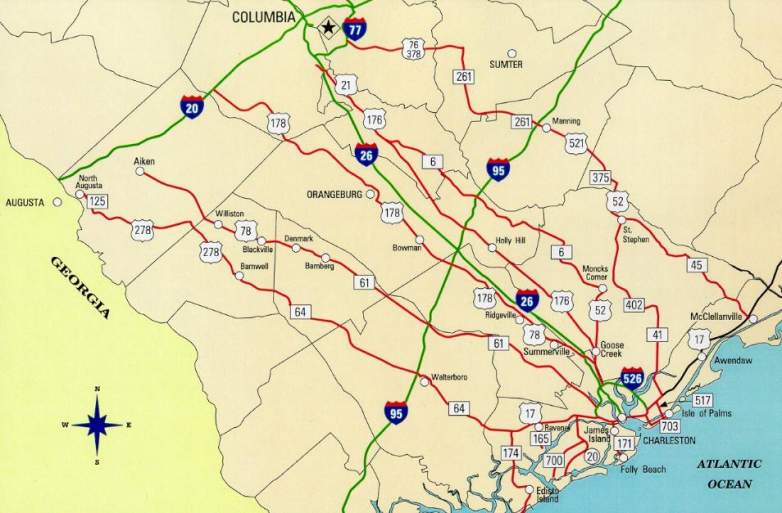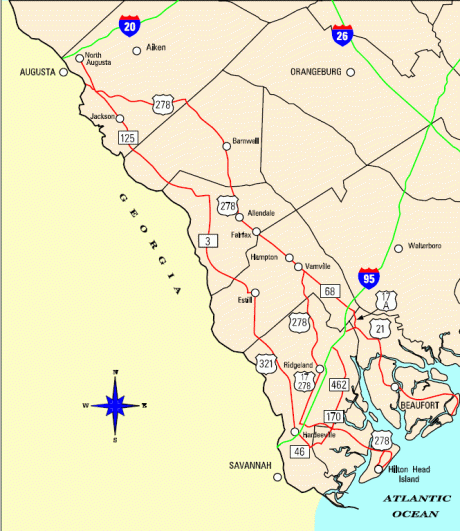
Mandatory evacuations are already being issued in parts of South Carolina ahead of Hurricane Florence, which has strengthened to a Category 4 and may be close to that strength when it makes landfall. More evacuations may be coming. The storm is currently expected to make landfall around Thursday, but hurricane paths are always a bit unpredictable. Read on for details about evacuation zones and maps for South Carolina in 2018, as Hurricane Florence approaches, so you can be prepared. This is a developing story.
Current South Carolina Evacuations
Gov. Henry McMaster has issued a mandatory evacuation order for the entire coastline of South Carolina, and mandatory evacuation procedures will begin Tuesday at noon. These evacuations are to ensure that residents don’t stay for the hurricane’s landfall.
Lanes will be reversed on four major highways, including U.S. 501, and state offices in 26 counties will be closed (as will schools.) A mandatory evacuation is also in place for certain hospitals in the area.
The following are a list of evacuation zones and routes in South Carolina according to the South Carolina Department of Transportation and other state government sources. Of course, these are only going to be instituted if evacuation orders have been issued in your region.
Evacuation Zones & Maps in South Carolina
If you’re unsure as to which evacuation zone you’re in within South Carolina, this map will help. It’s the Know Your Zone interactive map from SCEMD.
You can also use an app on iOS or Google to determine your evacuation zone using your phone’s location or physical address.
Here is another map, provided by SCEMD, which shows a detailed breakdown of evacuation zones for each area. You can see a larger map and zoom in here.
South Carolina has a 2018 hurricane guide which you can read here to help you prepare. This map, from South Carolina’s official guide, details the hurricane evacuation routes as designated by SCDOT:
Here are more details about evacuation routes based on your location, as provided by SCDOT and the Department of Public Safety. These will come into effect when evacuations are issued for the regions. These are divided into conglomerates and regions. Search for your city or county or region to find the areas that are relevant to you.
Northern Conglomerate Evacuation Map
This evacuation route includes Little River, North Myrtle Beach, Briarcliff Acres, Myrtle Beach, Socastee, Surfside Beach, Garden City, Murrells Inlet, Winyah Bay, and Georgetown. Learn more here.
SC Traffic (the Department of Public Safety) describes the northern evacuation routes this way:
- “North Myrtle Beach and northward: Evacuees from Briarcliff Acres and northward will take SC 9 north to I-95 and beyond.
- Briarcliff Acres south to Myrtle Beach 10th Avenue North: Evacuees from Briarcliff Acres south to 10thAvenue North will take SC 22 (Conway Bypass) to US 501 to Marion. In Marion, they may then take US 76 to Florence to access I-95 southbound or they may stay on US 501 to SC 38 to access I-95 northbound.
- Myrtle Beach, from 10th Avenue North south to the Myrtle Beach Airport: Evacuees from the Myrtle Beach area south of 10th Avenue North and north of the Myrtle Beach Airport will take US 501 to Conway.They may then take US 378 to Columbia or continue on US 501 to Marion. In Marion, they may then take US 76 to Florence to access I-95 southbound or they may stay on US 501 to SC 38 to access I-95 northbound.
- Myrtle Beach Airport southward through Surfside Beach: Evacuees from the Myrtle Beach area from the Myrtle Beach Airport southward through Surfside Beach will take SC 544 to US 501 to Conway.They may then take US 378 to Columbia or continue on US 501 to Marion. In Marion, they may then take US 76 to Florence to access I-95 southbound or they may stay on US 501 to SC 38 to access I-95 northbound.Garden City Beach south to Winyah Bay: Evacuees from Garden City Beach southward to Winyah Bay will take US 17 south through Georgetown. They will then take US 521 to SC 261 to US 378 to Columbia.Alternatively, they may take US 17 south to US 701 in Georgetown to SC 51 to US 378 at Kingsburg.”
Central Conglomerate Evacuation Map
This evacuation map includes Edisto Island, Adams Run, Yonges Island, Meggett, Hollywood, Ravenel, John’s Island, Kiawah Island, Seabrook, James Island, Folley Beach, City of Charleston, North Charleston, East Cooper, Mt. Pleasant, Sullivan’s Island, Isle of Palms, Awendaw, and McClellanville. Learn more here.
SC Traffic (the Department of Public Safety) describes the evacuation routes this way. (The following is quoted from SCTraffic.org):
- “Edisto Island and Adams Run: Evacuees from Edisto Island and Adams Run will take SC 174 to US 17. They will then take US 17 south to SC 64. SC 64 will take them to Walterboro and eventually to Augusta
- “Yonges Island, Meggett, Hollywood, Ravenel: [Evacuees from Yonges Island, Meggett, Hollywood and Ravenel will take SC 165 to US 17. They will then take US 17 south to SC 64. SC 64 will take them to Walterboro and eventually to Augusta.
- “Johns Island, Kiawah Island and Seabrook: Evacuees from Johns Island, Kiawah Island and Seabrook will use SC 700 and Secondary Road 20 (Bohicket Road) to US 17. They will then take US 17 south to SC 64. SC 64 will take them to Walterboro and eventually to Augusta
- “James Island and Folly Beach: Evacuees from James Island and Folly Beach will take SC 171 to US 17. They will then travel south on US 17 to I-526 to the reversed lanes of I-26
- “City of Charleston: Evacuees from the West Ashley area will use SC 61 to US 78. US 78 will take them to Aiken and eventually to Augusta. Evacuees from the downtown Charleston areas will use the normal westbound lanes of I-26
- “North Charleston: Evacuees from North Charleston will take US 52 (Rivers Avenue). They may take US 78 to US 178 to Orangeburg or they may stay on US 52 northbound to Goose Creek.
- At Goose Creek, traffic in the right lane of US 52 will continue on to Moncks Corner. In Moncks Corner, it will be directed onto SC 6, which will take evacuees to Columbia.
- Traffic in the left lane of US 52 at Goose Creek will be directed onto US 176 to Columbia.
- Evacuees travelling west on SC 642 (Dorchester Road) will go to Old Orangeburg Road (Secondary 22) to US 78.
- “East Cooper: Evacuees leaving Mt. Pleasant may take I-526 to I-26 or US 17 north to SC 41.
- Evacuees leaving Sullivan’s Island will use SC 703 to I-526 Business to access I-526 then I-26.
- Evacuees from the Isle of Palms would use the Isle of Palms Connector (SC 517) to go to US 17. The right lane will turn north on US 17, then proceed to SC 41, to SC 402, then to US 52 to SC 375, then to US 521, to SC 261 to US 378 to Columbia.
- Evacuees using the left lanes of the Isle of Palms Connector would turn left to go to I-526 then on to I-26.
- Evacuees in the right lane on I-526 approaching I-26 from the East Cooper area will be directed to the normal lanes of I-26. Evacuees in the left lane on I-526 will be directed into the reversed lanes of I-26.
- Evacuees travelling on I-26 in the normal westbound lanes of travel will be allowed to exit at all interchanges between Charleston and Columbia. Evacuees travelling in the reversed lanes of travel will be allowed to exit at most, but not all, interchanges.
- Re-entry to I-26 will be permitted at all interchanges, but only into the normal, not the reversed, lanes of travel.
- No motorists in the reversed lanes of travel will be allowed directly from I-26 onto I-95. However, they will be able to access I-95 via exit 165. They will take SC 210 north to US 176 east to I-95.
- I-26 westbound traffic in the normal travel lanes that does not exit prior to reaching Columbia will be routed onto I-77 north.
- I-26 westbound traffic in the reversed travel lanes that does not exit prior to reaching Columbia will be directed by law enforcement officers across the interstate median into the normal lanes of travel.
- Motorists are cautioned not to cross any roadway median unless directed to do so by a law enforcement officer.
- “Awendaw and McClellanville: Evacuees from Awendaw and McClellanville will take SC 45 to SC 6 to Columbia.
Southern Conglomerate Evacuation Map
This evacuation map includes Hilton Head, Beautfort, and Bluffton. Learn more here.
SC Traffic describes the evacuation routes this way. (The following is quoted from SCTraffic.org, provided by the Department of Public Safety):
- “Bluffton: Bluffton area evacuees will take SC 46 west to US 321. They will then take US 321 northbound to Estill. At Estill, they will take SC 3 to SC 125, which will take them to Augusta.
- “Hilton Head Island: Hilton Head Island evacuees will use both the William Hilton Parkway (US 278 Business) and the Cross Island Parkway toll facility (US 278). Evacuees will follow US 278 to I-95. Traffic in the right lane of US 278 will be routed onto I-95 north. Traffic in the left lane will continue along US 278.
- In order to facilitate the flow of traffic, lane reversals may be implemented along US 278. If this occurs, there will be numerous traffic control devices and law enforcement officers in place along the route to direct motorists accordingly.
- “Beaufort: Beaufort area evacuees will use the northbound lanes on US 21. Evacuees from the Beaufort area who plan to stay in American Red Cross shelters in Hampton County may take US 17 Alternate to SC 68 into Hampton County. These lanes will be routed onto US 17 south to I-95 at Exit 33 (Point South). The left lane will take I-95 south and the right lane will take I-95 north.
The following are the same evacuation details, but provided according to regions designated by SCDOT:
Grand Strand Area Evacuation Routes, Including Myrtle Beach and Garden City Beach
According to SCDOT, these are the following evacuation routes for the region, once evacuation orders are issued.
North Myrtle Beach and Northward
- Use SC 9 to proceed to I-95.
Myrtle Beach
- 10th Avenue North and northward to Briarcliff Acres use SC 22 (Conway Bypass) to US 501. Motorists using SC 31 (Carolina Bays Parkway) or the Grissom Parkway will be directed north to SC 22.
- South of 10th Avenue North southward to the Myrtle Beach Airport use US 501 toward Marion and beyond.
- Under certain conditions, US 501 will be converted to four lanes northbound from SC 22 to SC 576.
- Myrtle Beach Airport southward through Surfside Beach use SC 544 to US 501.
- Under certain conditions, US 501 will be converted to four lanes northbound from SC 544 to US 378. The reversed lanes will carry SC 544 traffic onto US 378 where it will travel westbound to I-95 or Columbia.
Garden City Beach South to Winyah Bay, Georgetown
Evacuation routes:
- Take US 17 south through Georgetown, then take US 521 to SC 261 to US 378 to Columbia.
- Under certain conditions, an alternate route from Georgetown will be Black River Road to US 701 to SC 51 to SC 41 to US 378 at Kingsburg.
Evacuation zones:
The following are the evacuation zones for Georgetown County, according to the Georgetown County government’s website:
- “Evacuation Zone A – Areas East of Highway 17 to the Atlantic Ocean from the South Santee River and North to the Horry County line, including Sandy Island; areas East of Dawhoo Lake and South of Walker Road and Powell Road to the South Santee River; all low-lying areas along the Waccamaw River, Great Pee Dee River, Black River, and Sampit River South of Highway 521 (17A), including Maryville; and all mobile home residents in the county.
- “Evacuation Zone B – Areas East of Dawhoo Lake and South of Walker Road to Powell Road to the South Santee River; all areas on the Atlantic Ocean side of Powell Road to Alt. US 17 to Highway 521 to Brick Chimney Road to State Highway 51 to Black River Road ending at the Black River; all low-lying areas along the Waccamaw River, Great Pee Dee River, and Black River, and all areas East of them to the coast; and all mobile home residents in the County.
- “Evacuation Zone C – Areas East of Dawhoo Lake and South of Walker Road to Powell Road to the South Santee River; all areas on the Atlantic Ocean side of Powell Road to Alt. US 17 to Highway 521 to Sawmill Road to Indian Hut Road to Carvers Bay Road (State Highway S-22-4) to Plantation Hill Road (State Highway 261) to Old Pee Dee Road to the Northern County Line; and all mobile home residents in the County.”
Charleston Area Evacuation Routes & Details
According to SCDOT, these are the following evacuation routes for the region, once evacuation orders are issued.
Edisto Island, Adams Run
- Evacuees will take SC 174 to US 17. They will then take US 17 south to SC 64. This will take them to Walterboro, and then to Aiken and I-20.
Yonges Island, Meggett, Hollywood, Ravenel
- Use SC 165 to US 17, then US 17 south to SC 64 where they will go to Walterboro, then to Aiken and I-20.
Johns Island, Kiawah Island and Seabrook
- Use SC 700 to Main Road (S-20) to US 17.
- Evacuees will then take US 17 south to SC 64 where they will go to Walterboro, then to Aiken and I-20.
James Island and Folly Beach
- Use SC 171 to US 17.
- Evacuees should then travel south on US 17 to I-526 to the reversed lanes of I-26.
Awendaw and McClellanville
- Evacuees will take SC 45 to US 52 where they will be directed right onto US 52 to SC 375 to US 521 to SC 261 to US 378 to Columbia.
City of Charleston
- The west side of the city (West Ashley) will use SC 61 to US 78, US 321, and SC 389 to I-20.
- Downtown will use the normal lanes of I-26.
Daniel Island
- Evacuees will take SC 45 to US 52 where they will be directed right onto US 52 to SC 375 to US 521 to SC 261 to US 378 to Columbia. Awendaw and McClellanville E
Hilton Head Island & Beaufort Area Evacuation Routes & Details
According to SCDOT, these are the following evacuation routes for the region, once evacuation orders are issued.
Hilton Head Island
- Hilton Head Island evacuees will use both the William Hilton Parkway (US 278 Business) and the Cross Island Parkway toll facility (US 278).
- As these two roads merge, a third lane will be formed by reversing flow on the inside eastbound lane of US 278. This lane will carry traffic from the toll facility to the three lane section beginning on the mainland.
- Lane assignments will be as follows:
- 1. The right lane on US 278 westbound will exit onto SC 170, proceed to SC 462, then be directed to I-95 northbound at I-95 exit 28.
- 2. The center lane on US 278 westbound will become the right lane at SC 170 which will be directed to I-95 northbound at exit 8.
- 3. The left lane on US 278 westbound at SC 170 will continue on US 278 to Hampton and eventually to North Augusta.
Beaufort
- Two-Lane Evacuation: Evacuees will use the two present northbound lanes on US 21 to US 17. Upon reaching US 17, the right lane will be directed to US 17 north to SC 303 to Walterboro. The left lane will be directed to US 17 south, then to US 17 Alt/US 21 to Yemassee and then ultimately to North Augusta.
- Three-Lane Evacuation: Under certain conditions, a third northbound lane will be formed by reversing flow in the inside southbound lane of US 21 at US 21 Business west of Beaufort, accommodating traffic from US 21. This reversed lane will be directed to US 17southbound and eventually I-95 northbound at exit 33 (Point South). The remaining two lanes will be used as described above for the two-lane evacuation.
North Charleston
- Evacuees will take US 52 (Rivers Avenue) to US 78 to US 178 to Orangeburg then to I-20 or continue on US 52 to US 176 or continue north on US 52.
- The right lanes of US 52 at Goose Creek will continue on to Moncks Corner. In Moncks Corner, evacuees will be directed onto SC 6, where SC 6 will take them toward Columbia.
- The left lanes of US 52 at Goose Creek will go onto US 176 to Columbia.
- Evacuees using SC 642 will travel west toward Summerville and take road S-22 (Old Orangeburg Road) to US 78 west.
East Cooper
- Evacuees leaving Mount Pleasant will take I-526 or US 17 south to I-26.
- Those leaving Sullivan’s Island will use SC 703 to I-526 Business to access I-526, then I-26.
- Evacuees from the Isle of Palms will use the Isle of Palms connector (SC 517) to go to US 17, where the right lane will turn north on US 17, then proceed to SC 41, to SC 402, then to US 52 to SC 375, then to US 521, to SC 261 to US 378 to Columbia.
- Evacuees using the left lanes of the Isle of Palms connector will turn left to go to I-526 and then on to I-26.
- Evacuees on I-526 approaching I-26 from East Cooper will be directed to the normal lanes of I-26 if in the right lane of I-526.
- Those in the left lane of I-526 will be directed into the reversed lanes of I-26.
READ NEXT: North Carolina evacuation routes and maps
